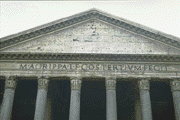PANTHEON
Imagine a circular building 43.3 metres (142 ft) in diameter and 43.3 metres in height, able to contain a perfect sphere, the roof of which follows that perfect sphere up to a circular opening. This grand conception for a temple was built in 27 BCE by Agrippa and dedicated to the patron gods of the Julio-Claudian family, Venus, Mars and the Divine Julius.
 It is doubtful, however, that the circular concept was his. The temple was restored twice, once by Domitian in 80 CE, and then by Hadrian in around 120 CE. Archaeologists working on the foundations of the building have shown that the temple originally faced south and so the pillared porch facing north that now graces the front of the Pantheon was a later addition probably by Hadrian, at the same time the temple was enlarged toward south and englobed a previous temple dedicated to Nettuno. Anyway Hadrian mainteined the dedication on the architrave above the porch: "M. Agrippa L. f. cos tertium fecit" ("Marcus Agrippa, son of Lucius, three time consul built [it]"). It is doubtful, however, that the circular concept was his. The temple was restored twice, once by Domitian in 80 CE, and then by Hadrian in around 120 CE. Archaeologists working on the foundations of the building have shown that the temple originally faced south and so the pillared porch facing north that now graces the front of the Pantheon was a later addition probably by Hadrian, at the same time the temple was enlarged toward south and englobed a previous temple dedicated to Nettuno. Anyway Hadrian mainteined the dedication on the architrave above the porch: "M. Agrippa L. f. cos tertium fecit" ("Marcus Agrippa, son of Lucius, three time consul built [it]").
Looking at the east and the west sides of the building you can discover a lot of particulars and imagine how refined was the decoration.
When Rome fell, the Pantheon was saved by the Byzantine Emperor Phocas donating the building to Pope Boniface IV who converted the temple into a church, Saint Mary and the Martyrs. The building underwent a cosmetic change during the baroque period when Bernini was asked to add belltowers to the Pantheon. These belfries were quickly dubbed "Bernini's ass's ears" and were finally removed when the building was restored in 1883.
Walking into the interior of the Pantheon you will appreciate the enormity of the columns that form the pillared porch. Once inside, in the cool air, you'll find youself looking up in awe at the size of the area above you, until your eyes find the opening in the dome. It's said that when it rains you won't get wet standing under the opening because the water will evaporate before it hits.
The floor of the interior is finely polished marble in patterns of the style called "Opus Sectile" which was popular in ancient Rome. There a niches around the wall that originally held statues of the divinities; inside one of them, during the Renaissance, Melozzo da Forlì painted a wonderful “Annunciazione”.
Buried here are Victor Emmanuel II (first king of Unified Italy), King Umberto I and the great Renaissance artist, Raffaello, close to another great: Annibale Carracci.
The Rotonda Square (Piazza del Pantheon) today is a lively place with a beautiful fountain and numerous open air bars where the tourist can rest and appreciate the atmosphere of the piazza with old buildings on three sides and the Pantheon on the fourth.
Ian Hutchesson
back |

